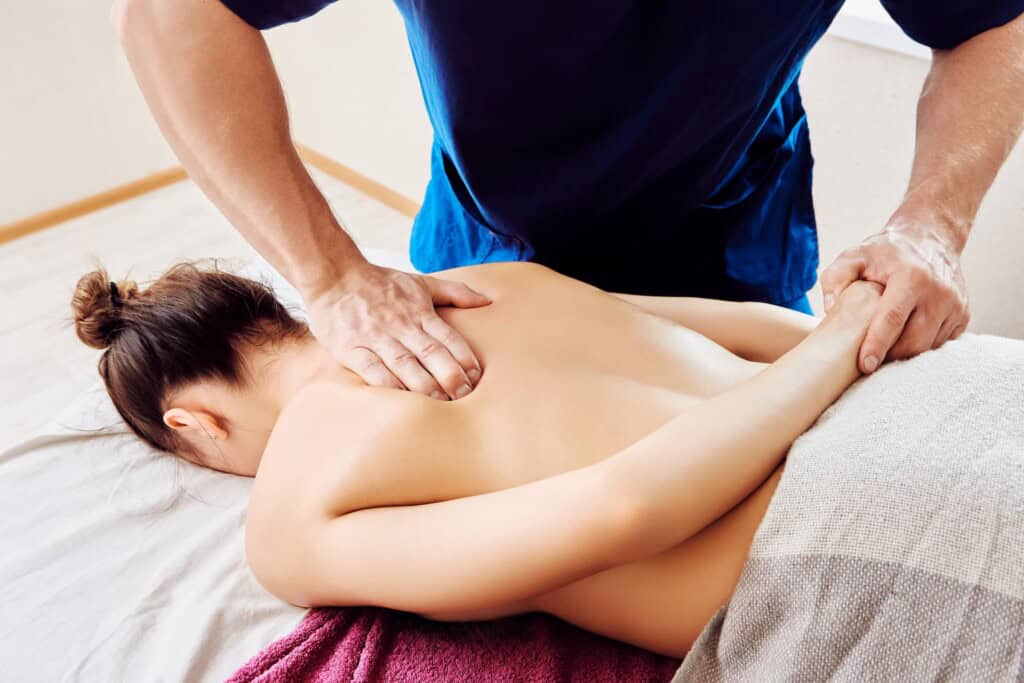Do you ever feel like the stress of the day is physically weighing you down? For many of us, upper back pain isn’t just an occasional annoyance; it’s a constant reminder that our bodies are asking for help. Whether it’s caused by long hours at a desk, a tough workout, or life’s daily pressures, that nagging discomfort can impact every part of your day. But here’s the good news: bodywork might just be the game-changer you need.
But what exactly does upper back pain look like? Understanding the symptoms is the first step toward finding relief.

Upper back pain can manifest in a variety of ways. Maybe you’re dealing with:
For some, the pain is a constant companion; for others, it flares up after specific activities. Regardless, it can make even the simplest tasks feel like a challenge.

Your upper back pain likely didn’t appear out of nowhere. Here are some common culprits:
Slouching at your desk or constantly looking down at your phone (often called “tech neck”) strains your upper back muscles and disrupts the natural alignment of your spine. Over time, this strain leads to discomfort or chronic pain.
Ever notice your shoulders creeping up toward your ears when you’re stressed? That tension can create long-term pain if left unchecked. The upper back often carries the physical manifestations of emotional stress, making relaxation as important as physical care.
Athletes, laborers, and even parents lifting their kids constantly can overwork their upper back muscles. These repetitive movements can lead to tightness, spasms, or even small injuries.
Issues like arthritis, scoliosis, or herniated discs can exacerbate discomfort. While these conditions may not always be fully resolved, managing the pain and improving mobility is possible.
Good posture is important for your overall health. Sitting or lying down for long periods can weaken the muscles that support good posture.
When these muscles get weak, the tissue around them, called fascia, can stick to your ribs or spine. This can lead to tightness, stiffness, and pain in your upper back.
If you’ve ever popped a painkiller or slapped on a heat patch, you know these methods can provide temporary relief. But they often fail to address the underlying causes of pain. Here’s why conventional treatments sometimes fall short:
Bodywork, on the other hand, focuses on the whole person. It addresses not just the symptoms but the root causes of discomfort, providing long-term relief.

Bodywork uses hands-on techniques to ease tension, restore balance, and support healing. It’s more than a quick fix; it helps your body heal and work at its best.

Bodywork isn’t a “one-size-fits-all” solution. It is tailored to your unique situation and symptoms, making it effective for diverse cases. Here’s how it works:
Tight muscles are a major cause of upper back pain. Techniques like deep tissue massage and trigger point therapy help loosen these tight spots and relax your muscles. It’s like pressing a reset button to ease pain and restore comfort.
Slouching or sitting too long can strain your back. Bodywork releases tight muscles and strengthens weaker ones, helping your body return to its natural alignment. This can reduce pain caused by poor posture and prevent it from coming back.
Good circulation helps your body heal. Bodywork improves blood flow, bringing oxygen and nutrients to sore or damaged areas and speeding up recovery.
Pain isn’t always just physical. Stress often builds up in your upper back and shoulders. Bodywork helps release this tension, easing both physical pain and emotional stress, so you feel lighter and more relaxed.
Pain and stiffness in the upper back can limit how you move. Bodywork gently increases flexibility and reduces tightness, making everyday movements easier and more comfortable.
Stella, one of my clients, came to me with intense upper back pain after starting a new job that required hours at her laptop. She was taking over-the-counter painkillers daily and even considered cortisone shots.
After a few sessions of myofascial release and postural adjustments, Stella noticed a difference. By her fourth session, she had ditched the painkillers entirely. With consistent follow-up sessions and stretches at home, she’s now pain-free and thriving at work.

Bodywork is versatile enough to help people from all walks of life:
If you’re new to bodywork, here’s what you can look forward to:
Your bodyworker will ask about your pain, lifestyle, and goals to customize your session.
Expect a mix of methods tailored to your specific needs. Your bodyworker will target areas of tension and imbalance.
Many bodyworkers offer tips for sustaining relief, like stretches, ergonomic adjustments, or mindfulness exercises.
Bodywork isn’t just about fixing your upper back pain—it’s about improving your entire life. Here’s what else you can expect:

Your pain doesn’t have to define your life. Bodywork is a safe, effective, and holistic way to address not just the symptoms but the causes of your discomfort. If you’re ready to take the first step toward relief, now is the time to act.
Life is too short to live with pain. Schedule your session today and discover how bodywork can make a difference. Let’s get you back to feeling your best!